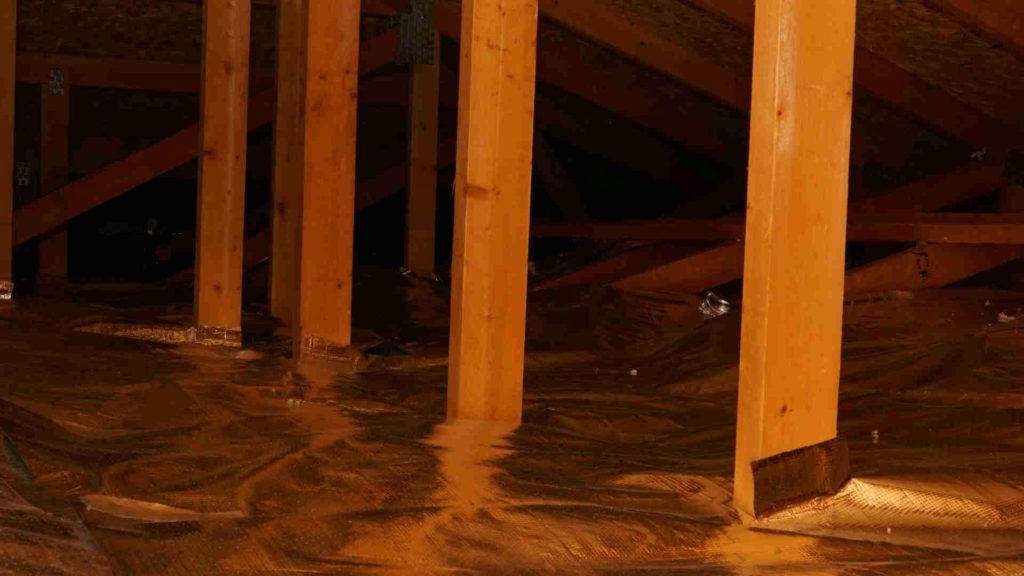Placing perforated radiant barriers directly on top of attic insulation in mixed and cold climates improves the thermal performance of insulation. Radiant barriers reduce heat loss caused by convective looping and wind washing which insulation alone may be susceptible to.
Radiant heat transfer
Everything with a temperature greater than 0oK emits radiant heat. Radiant heat primarily transfers by either electromagnetic, infrared or UV waves. Other objects either absorb or reflect these radiant waves. If the waves reflect off an object, they will continue to travel until another object absorbs them. Radiant heat transfer, unlike conductive heat transfer, does not require direct contact for heat transfer to take place. One prominent example of radiant heat transfer would be to place your hand near a lit candle. The radiant heat from the candles flame transfers through the air and your hand absorbs the heat.
How perforated radiant barriers work
Perforated radiant barriers are usually made from aluminum. Aluminum is a cost effective material that has high reflectivity as well as low emissivity. Percentage values are used to represent a materials reflectivity and emissivity. Aluminum typically has a reflectivity of 97% and an emissivity of 3%. This means that 97% of the radiant heat directed at a piece of aluminum reflects away from the aluminum. The radiant heat reflected from aluminum will eventually absorb into some other non reflective object. Aluminum’s emissivity rating of 3% represents the aluminum’s ability to transfer heat in the form of radiation.
Since emissivity is a little more intricate to understand, we will use another example similar to the hand and candle one used previously. This time, replace the candle with a piece of aluminum heated to 200oF. When you place your hand near the heated aluminum, only 3% or 6oF of its radiant heat absorbs into your hand. However, if you were to touch the piece of aluminum, the full 200oF would transfer to your hand via conduction.
To demonstrate how radiant barriers work, we can continue with the hand and candle example, with the addition of a piece of aluminum foil. This time the radiant heat from the candles flame transfers through the air and 97% of it reflects back towards the candle rather than your hand. In hot climates, this theory holds true. Radiant heat from the building’s roof reflects back towards the roof rather than absorbing into the attic insulation.


Radiant barriers in mixed and cold climates
In mixed and cold climates, the living space can be the source of radiant heat compared to the attic. The living space is typically kept around 70oF, while the attic temperature is lower, possibly between 0oF and -40oF. However, using the same theory applied to warm climates and reversing it does not necessarily have the same benefits. The reason for this is that radiant heat transferring from the living space to the attic space absorbs into the attic insulation. Lower levels of radiant heat at the top of the insulation will not pass through to the attic since radiant barriers have low emissivity values. However the efficiency benefits of this are relatively minimal.
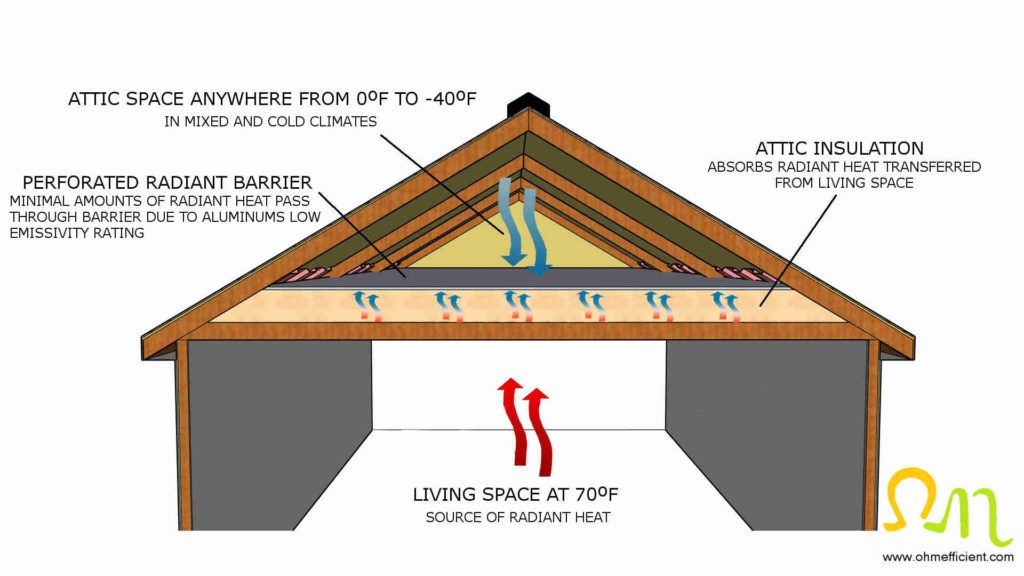
Natural and forced convection losses
Convective heat transfer is the transfer of heat from one place to another by the movement of air. Convection can occur naturally as warm air rises, or forcefully from wind gusts or HVAC equipment. Building efficiency relating to convective heat transfer losses is important to understand in order to reduce their undesirable effects. Refer to Duct sealing improves HVAC system efficiency for more information.
Convective looping within attic insulation
Convective looping is a thermal buoyancy cycle where rising warm air gets replaced by falling cold air. Ideally the air at the lowest portion of attic insulation should be the warmest and transition to cool as it nears the top of the insulation. The natural convection of falling, cold attic air displacing the lower, warmer air via the convective looping cycle decreases insulation efficiency. The rate that convective looping occurs is proportional to the differential temperature between the attic space and the living space. The greater the temperature difference, the more losses can be expected as a result of convective looping.

Laying perforated radiant barrier on top of attic insulation provides an air barrier between the cold attic and the insulation. Placing an air barrier between the cold attic air and the insulation will reduce convective looping and increase attic insulation efficiency.
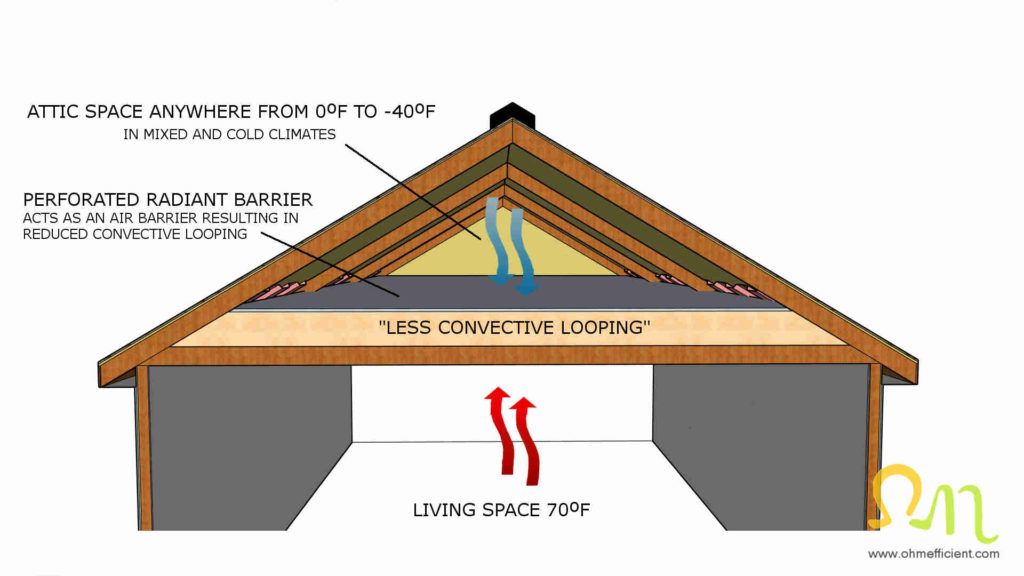
Note
Some loose-fill insulation manufactured in the early 1990’s had relatively large air spaces that made the insulation very permeable. This insulation is very susceptible to convective looping and is not efficient when used in cold climates. Loose-fill insulation manufactures have since made modifications to provide resistance to air movement which now inhibits the convective cycle.
Wind washing attic insulation
Windy days expose roofs to positive pressures on the wind facing sides and negative pressures on the downwind sides. Air enters the attic from the vents facing the wind and exits the attic from the vents that are downwind. Attic ventilation lowers attic temperature in the summer and removes moisture during the winter. However, if this wind passes through the insulation, it will strip the heat away from the insulation decreasing its efficiency.
Correctly installed attic rafter vents prevent wind washing from directly flowing through the insulation. Air should enter the soffit vent and proceed up the rafter vent and exit the exhaust vent near or at the ridge of the roof. However, on windy days, the wind can pass through the top layer of insulation on its way out the downwind side.
Laying perforated radiant barrier on top of attic insulation provides an air barrier to prevent this wind from stripping heat away from the insulation.
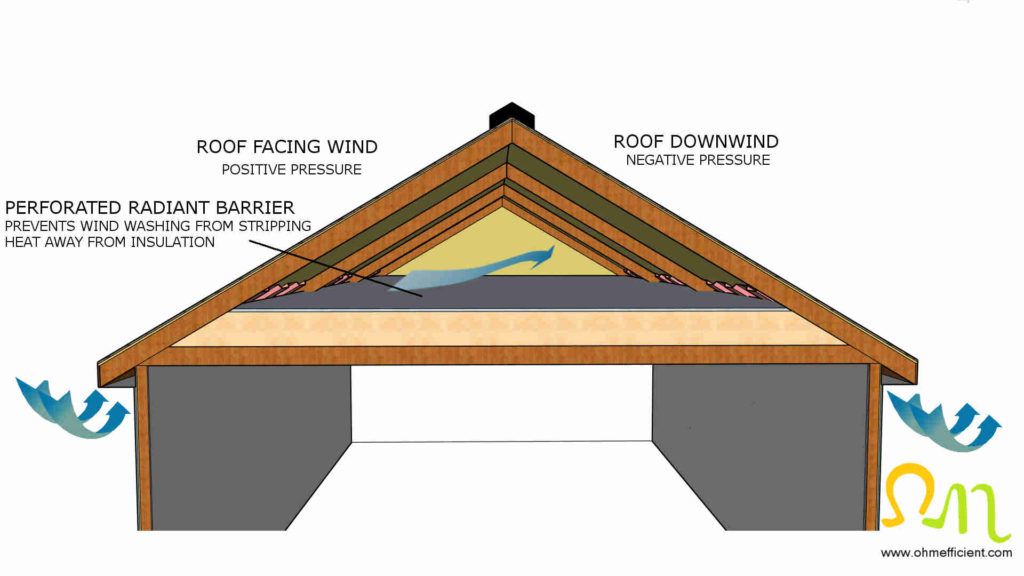
Caution!
Seal all ceiling penetrations before installing radiant barriers
Before installing perforated radiant barrier on top of attic insulation, it is important to seal all penetrations between the living space and attic. This needs to be as air tight as possible to prevent moisture from entering the attic from the living space.
Watch this video for proper ways to seal the living space from the attic space:
Radiant barriers need to be perforated when they are directly installed on top of attic insulation. When the attic space is cold, the perforated radiant barrier will also be a cold surface. Perforated radiant barriers are moisture permeable which allows water vapor to pass through. However, if too much water vapor enters the attic from the living space, it will condense on the cold underside of the radiant barrier. If water condenses on the radiant barrier, multiple problems may occur. The attic insulation may become wet and lose its insulating efficiency. Water spots may start to appear on sheetrock ceiling above the living space. The worst case scenario would be that the ceiling framing could rot.


Additional benefits radiant barriers provide in mixed and cold climates
During hot summer months, roofs absorb solar radiant heat emitted by the sun. The radiant heat causes the temperature within the attic space to increase. Radiant heat from the roof, then transfers and absorbs into the attic insulation. The attic insulation top surface temperature increases due to the absorbed radiant heat. Since heat transfers from warm to cool objects via conduction, this heat works its way down into the living space. This results in either the air conditioning operating more often or the living space to become uncomfortable. It is worth mentioning that attic ventilation does not cool down radiant heat transfer as air does not absorb radiation.
The addition of a perforated radiant barrier laying on top of the attic insulation will keep the insulation cooler. The insulation is cooler because radiant heat from the roof reflects back to the roof. As a result the insulation no longer absorbs this radiant heat. The top surface temperature of the attic insulation therefore remains close to ambient outdoor temperature. The degree to which conductive heat transfers into the living space reduces because the differential temperature between the living space and attic insulation is less. This results in either the air conditioning operating less frequently or the living space to become more comfortable.
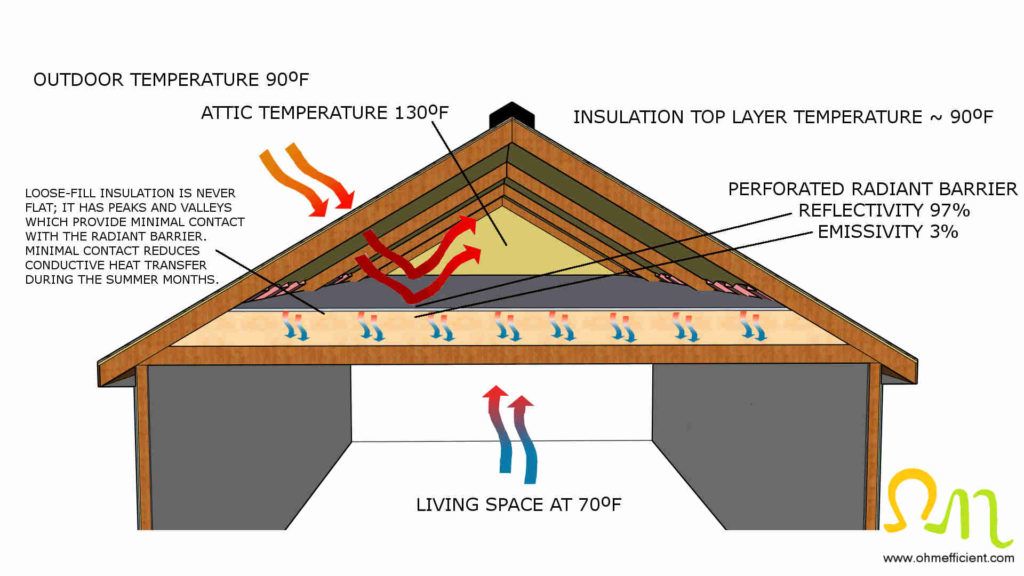
Note
Loose-fill insulation is never flat; it has peaks and valleys which provide minimal contact with the radiant barrier. Minimal contact reduces conductive heat transfer during the summer months.
Other measures to prevent radiant barrier condensing issues
- select perforated radiant barriers with higher permeability ratings
- avoid high living space relative humidity levels
- use vapor retarder between sheetrock and attic insulation
- ensure proper attic ventilation
Conclusion
Installing a perforated radiant barrier directly on top of attic insulation increases winter and summer efficiencies in mixed and cold climates. In the winter, it reduces heat loss from convective looping and wind washing. In the summer it reduces heat gain by reducing attic insulation top surface temperature. Ensuring there are no leaks coming from the living space is extremely important before installing perforated radiant barrier on top of the attic insulation.
Tools & parts required
Radiant Barrier
Utility Knife
Half Faced Respirator with a P100 Filter
Body Suite
Clamp Lights
Extension Cord
Measuring Tape
HVAC Aluminum Foil Tape (for esthetics only)
2×6 Boards (to place down and walk on)
Step Ladder (to gain access to the attic space)
Related articles
How to install blown-in attic insulation
Cool Roofs Reduce Air Conditioning Costs
Radiant Barriers Lower Air Conditioning Costs

